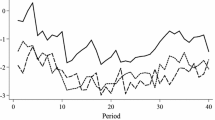Abstract
This paper provides a theoretical explanation for the common observation that people often fail to purchase insurance against low-probability high-loss events even when it is offered at favorable premiums. We hypothesize that individuals maximize expected utility but face an explicit or implicit cost to discovering the true probability of rare events. This cost constitutes a threshold that may inhibit purchase but may be offset in several ways by suppliers of insurers and state regulators.
Similar content being viewed by others
References
Business Insurance. (2001). “Better Off Buying Life Insurance?” p. 8.
Baumol, William and Richard Quandt. (1964). “Rules of Thumb and Optimally Imperfect Decisions,” American Economic Review 54, 23-46.
Conlisk, John. (1996). “Why Bounded Rationality?” Journal of Economic Literature 34, 669-700.
Doherty, Neil. (2000). Integrated Risk Management. New York, NY: McGraw Hill.
Freifelder, Leonard. (1975). “Statistical Decision Theory and Credibility Theory Procedures.” In P.M. Kahn (ed.), Credibility: Theory and Applications. New York: Academic Press, 71-88.
Froot, Kenneth, David Scharfstein, and Jeremy Stein. (1993). “Risk Management: Co-ordinating Investment and Financing Problems,” Journal of Finance 48, 1629-1658.
Grace, Martin, Robert Klein, Paul Kleindorfer, and Michael Murray. (2003). Catastrophe Insurance: Consumer Demand, Markets and Regulation. Boston: Kluwer Academic Publishers.
Hogarth, Robin and Kunreuther Howard. (1992). “Pricing Insurance and Warranties: Ambiguity and Correlated Risks,” The Geneva Papers on Risk and Insurance Theory 17, 36-50.
Huber, Oswald, Roman Wider, and Odilo Huber. (1997). “Active Information Search and Complete Information Presentation in Naturalistic Risky Decision Tasks,” Acta Psychologica 95, 15-29.
Kahneman, Daniel and Amos Tversky. (eds.). (2000). Choice, Values, and Frames. Cambridge England: Cambridge University Press.
Knight, Frank. (1921). Risk, Uncertainty and Profit. Boston: Houghton-Mifflin, 1921. Reprinted, New York, NY: Sentry Press, 1964.
Kunreuther, Howard, Nathan Novemsky, and Daniel Kahneman. (2001). “Making Low Probabilities Useful,” Journal of Risk and Uncertainty 23, 103-120.
Kunreuther, Howard. (1998). “Insurability Conditions and the Supply of Coverage.” In Howard, Kunreuther and Richard Roth Sr. (eds.), Paying the Price: The Status and Role of Insurance Against Natural Disasters in the United States. Washington, DC: Joseph Henry Press.
Kunreuther, Howard, Robin Hogarth, and Jacqueline Meszaros. (1993). “Insurer Ambiguity and Market Failure,” Journal of Risk and Uncertainty 7, 71-87.
Lecomte, Eugene and Gahagan Karen. (1998). “Hurricane Insurance Protection in Florida.” In Howard, Kunreuther and Richard Roth Sr. (eds.), Paying the Price: The Status and Role of Insurance Against Natural Disasters in the United States. Washington, DC: Joseph Henry Press.
Lindley, Dennis. (1971). Making Decisions. London: Wiley-Interscience.
Mumpower, Jeryl. (1991). “Risk, Ambiguity, Insurance, and the Winner's Curse,” Risk Analysis 11, 519-522.
Pauly, Mark. (1983). “Insurance Market Equilibria With Credibility Adjusted Premiums,” International Institute for Applied Systems Analysis Working Paper WP-83-26.
Phelps, Charles. (1997). Health Economics (2nd Edition). Reading, MA: Addison-Wesley.
Schmeidler, David. (1989). “Subjective Probability and Expected Utility Without Additivity,” Econometrica 57, 571-587.
Stone, James. (1973). “A Theory of Capacity and the Insurance of Catastrophe Risks,” Journal of Risk and Insurance 40, 231-243 (Part I) and 339–355 (Part II).
Svenson, Ola. (1981). “Are We All Less Risky and More Skillful Than Our Fellow Drivers Are?” Acta Psychologica 57, 143-148.
Winter, Sidney. (1975). “Optimization and Evolution in the Theory of the Firm.” In R. H. Day and T. Groves (eds.), Adaptive Economic Models. New York, NY: Academic Press.
Author information
Authors and Affiliations
Corresponding author
Rights and permissions
About this article
Cite this article
Kunreuther, H., Pauly, M. Neglecting Disaster: Why Don't People Insure Against Large Losses?. Journal of Risk and Uncertainty 28, 5–21 (2004). https://doi.org/10.1023/B:RISK.0000009433.25126.87
Issue Date:
DOI: https://doi.org/10.1023/B:RISK.0000009433.25126.87




